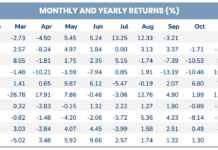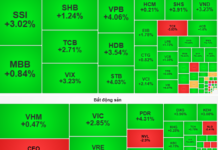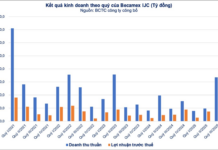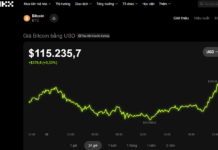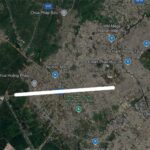
Illustration of a 108-story financial tower in Dong Anh, Hanoi.
|
Based on the approved plan, the Hanoi People’s Committee believes that the construction of the 108-story Financial Tower, part of the Smart City project, is in line with the approved plan. The Hanoi People’s Committee agrees and supports the proposal to study and design the 108-story Financial Tower as a complex of internationally renowned structures (according to the report proposed by the Company), contributing to promoting the image of Hanoi Capital and Vietnam to the world.
This is the noteworthy content in Document No. 460/UBND-ĐT regarding the static height of the 108-story Financial Tower in the Smart City investment project, Dong Anh district (Hanoi), which was recently sent by the Hanoi People’s Committee to the Ministry of Transport for their new opinions.
According to the content of the above-mentioned Document, the specific implementation of the Hanoi Capital Construction Master Plan until 2030 and the vision until 2050, which was approved by the Prime Minister in Decision No. 1259/QD-TTg on July 26, 2011, and related documents from various competent authorities regarding the approval of the investment policy for the Smart City project in Hai Boi commune, Vinh Ngoc commune, Dong Anh district with the goal of establishing and developing a new smart urban area, synchronized along the Nhat Tan-Noi Bai axis, developing high-rise, modern financial, banking, and commercial service centers. Accordingly, it is determined to construct a 108-story mixed-use Financial Center on a land area of 133,279m2.
Currently, BAC Hanoi Investment and Development Corporation (the implementing economic organization of the project) is carrying out the investment procedures for the above-mentioned mixed-use Financial Center project (Financial Tower) with a 108-story high-rise structure, expected to reach a height of 639m with the aim of becoming the tallest building in Vietnam.
The Document of the Hanoi People’s Committee cited the report from BAC Hanoi Investment and Development Corporation, in which the company contacted the Combat Bureau – General Staff Department for approval of the static clearance of the Financial Tower according to the regulations of Decree No. 32 /2016/NĐ-CP dated May 6, 2016 of the Government on the management of the static clearance of aviation obstacles and strategic areas for the management and protection of Vietnamese airspace and obtained opinions from the Combat Bureau – General Staff Department, the Air Defense – Air Force Staff and the Civil Aviation Authority of Vietnam – Ministry of Transport.
The Air Defense – Air Force Staff issued Official Letter No. 6259/BTM-QLĐHB on December 18, 2023, in which they expressed their opinion that the height of 639m for the land area of the Smart City project does not affect the flight operations of the Air Defense – Air Force and does not affect the Ba Dinh parade and march routes.
The Civil Aviation Authority of Vietnam – Ministry of Transport issued Official Letter No. 7442 CHK-QLHĐB on December 25, 2023, in which they conducted a preliminary evaluation and determined that the height of the project (3.3.4-TTTC TM) at 639m above 7.25m ground level does not affect the obstacle limitation surfaces at Noi Bai Airport; however, the project has an impact on civil aviation flight procedures at Noi Bai Airport…; this obstacle also affects the minimum sector altitudes (MSA) and the minimum sector altitudes for surveillance (MVA) diagrams. The height does not affect the existing flight procedure system at Noi Bai Airport, which is 354m.
The Hanoi People’s Committee requests a consideration of the important nature of the project, and if the decision is made to construct this project, it requires the Investor, consulting and surveying units to coordinate with the Combat Bureau, the Civil Aviation Authority of Vietnam, and the Vietnam Air Traffic Management Corporation to review and supplement the accuracy of the input data (especially the decimal coordinates of the project) to have a detailed research plan, impact assessment, detailed calculations, and review the height of the project or adjust the related flight procedure system at Noi Bai Airport (including the existing situation and the expected situation according to the plan).
To provide a basis for the Combat Bureau – General Staff Department to approve the static clearance of the Financial Tower and for BAC Hanoi Investment and Development Corporation to complete the investment procedures, the Hanoi People’s Committee requests the Ministry of Transport to consider and direct the Civil Aviation Authority of Vietnam and the Vietnam Air Traffic Management Corporation to coordinate with the Combat Bureau – General Staff Department and relevant units to study and assess the expected static clearance height of the proposed 108-story Financial Tower and related technical requirements.
Regarding the construction of the 108-story Tower that meets the planning criteria, but the city still has to seek the opinion of the Ministry of Transport, the leaders of the Hanoi Planning and Architecture Department said that it is because of the flight safety regulations.
On November 11, in Dong Anh district, BAC Hanoi Investment and Development Corporation, a joint venture between BRG Group (Vietnam) and Sumitomo Group (Japan), officially announced the implementation of the BAC Hanoi Smart City.
The BAC Hanoi Smart City project is expected to have a total investment of nearly $4.2 billion on a total area of nearly 272 hectares in Hai Boi, Vinh Ngoc, and Kim No (Dong Anh) communes.
The BAC Hanoi Smart City will apply the essence of the Industrial Revolution 4.0 worldwide, aiming to create a sustainable city model through green living and the application of modern technology.
The BAC Hanoi Smart City is built on 4 core values: “Future-Connected-Clean-Safe” and applies 6 smart solutions, including smart energy, smart mobility, smart management, smart living, smart health and learning, and finally, a smart economy.
Mạnh Khánh














